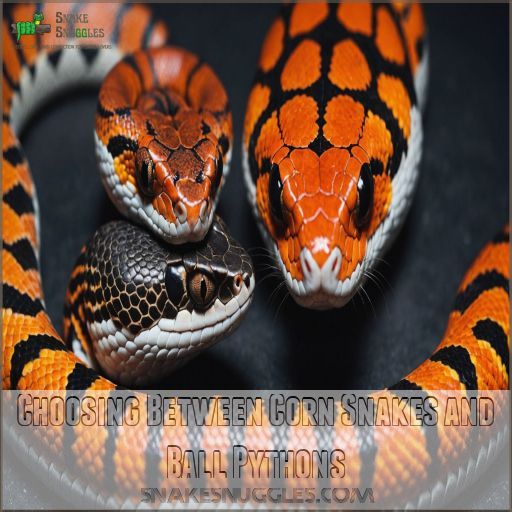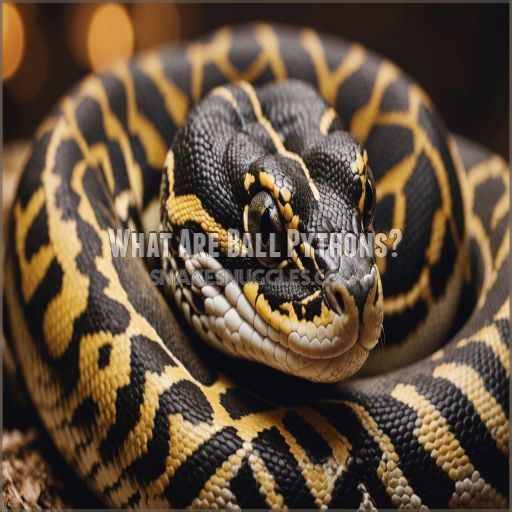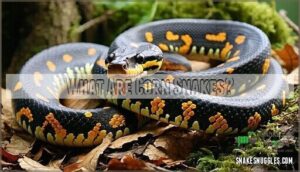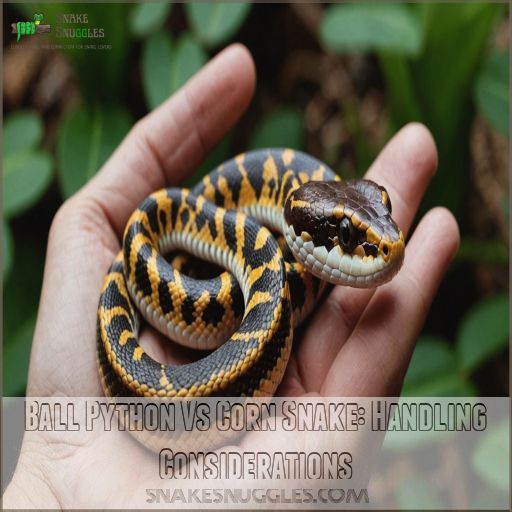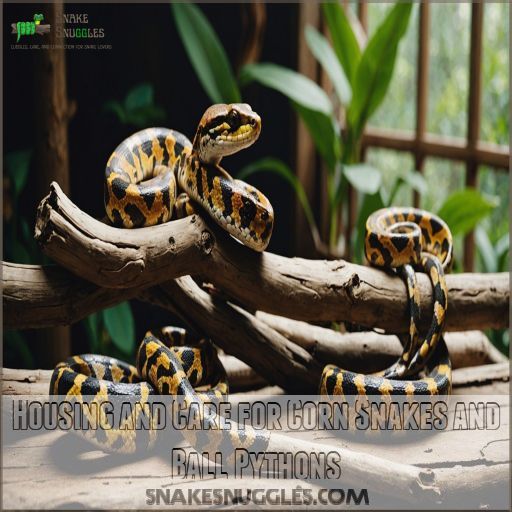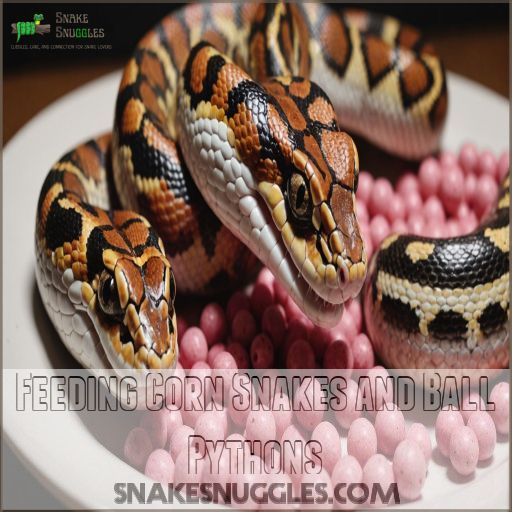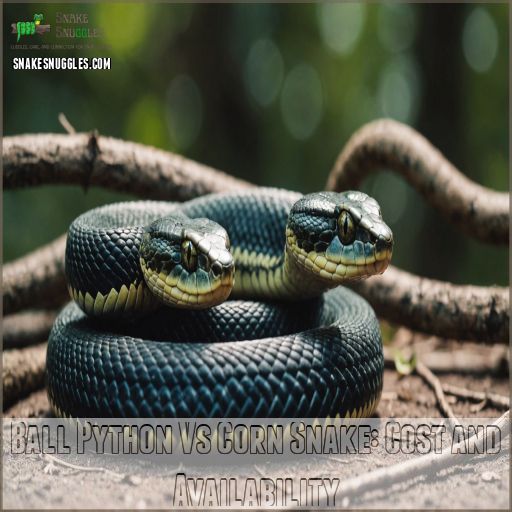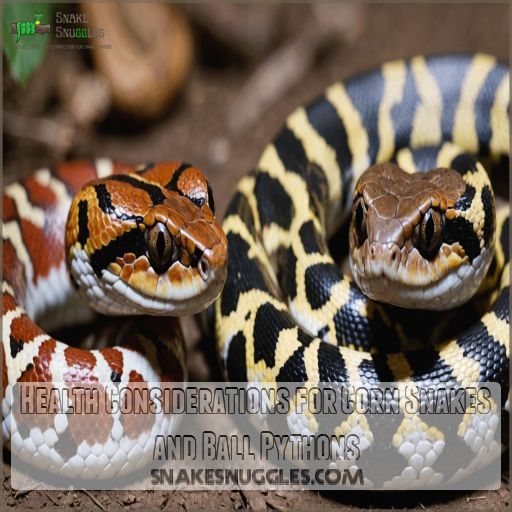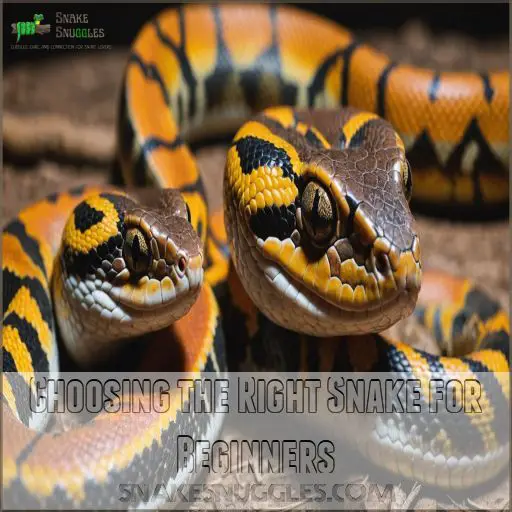This site is supported by our readers. We may earn a commission, at no cost to you, if you purchase through links.
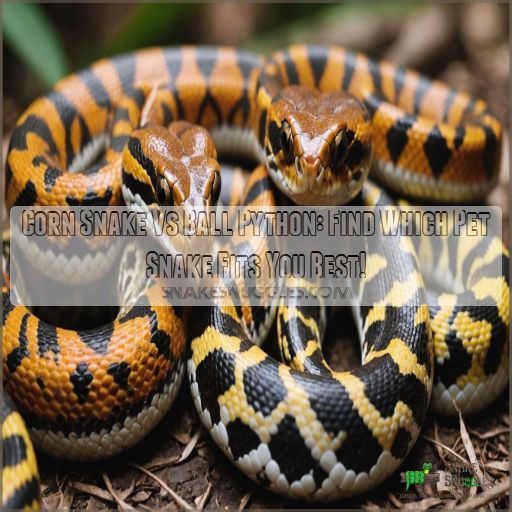 Trying to decide between a corn snake or ball python? Let’s break down the key differences. Corn snakes are the more social, curious type – they come in a rainbow of colors and max out around 4 feet.
Trying to decide between a corn snake or ball python? Let’s break down the key differences. Corn snakes are the more social, curious type – they come in a rainbow of colors and max out around 4 feet.
Ball pythons are the shy, reserved ones that can live up to 50 years and get a bit chunkier at 5 pounds.
Both make great first-time pets, but corn snakes are a bit more budget-friendly.
Handling-wise, corn snakes are happy to hang out, while ball pythons need a gentler touch.
Whichever you choose, proper care is a must. Now, let’s get into the details to help you pick your new slithery bestie!
Table Of Contents
- Key Takeaways
- Choosing Between Corn Snakes and Ball Pythons
- What Are Ball Pythons?
- What Are Corn Snakes?
- Ball Python Vs Corn Snake: Handling Considerations
- Housing and Care for Corn Snakes and Ball Pythons
- Feeding Corn Snakes and Ball Pythons
- Ball Python Vs Corn Snake: Cost and Availability
- Health Considerations for Corn Snakes and Ball Pythons
- Choosing the Right Snake for Beginners
- Frequently Asked Questions (FAQs)
- What is the difference between a ball python and a corn snake?
- Are ball pythons a good pet snake?
- Do pythons live longer than corn snakes?
- Will a corn snake bite a ball python?
- Are ball pythons or corn snakes nicer?
- Are corn snakes for beginners?
- Can corn snakes be friendly?
- Do corn snakes like to be touched?
- Do corn snakes and ball pythons have fangs?
- Are corn snakes more active than ball pythons?
- How long do corn snakes live compared to ball pythons?
- Are corn snakes easier to care for than ball pythons?
- What are the color morph differences in corn snakes and ball pythons?
- Conclusion
Key Takeaways
- Corn snakes are the social butterflies – they’re curious, come in vibrant colors, and max out at around 4 feet. Ball pythons are the shy, reserved ones that can live up to 50 years and get a bit chunkier, at 5 pounds. Both make great first-time pets, but corn snakes are a bit more budget-friendly.
- Handling corn snakes is a breeze – they’re happy to hang out. Ball pythons need a gentler touch, but their docile nature makes them the "teddy bears" of the snake world. Just be mindful of their size and weight differences when handling them.
- Setting up the right home is key. Corn snakes are active climbers, so they need a taller enclosure. Ball pythons prefer a cozy, humid hideaway. Get the temperature and humidity just right, and you’ll have happy, healthy snakes.
- Corn snakes are the low-maintenance friends who will eat just about anything, while ball pythons can be picky eaters. But with the right feeding schedule and prey size, you’ll keep both species thriving. Just don’t forget to wash your hands after handling those rodents.
Choosing Between Corn Snakes and Ball Pythons
are like that low-maintenance friend who’s always up for a chat.
Ball pythons are the chill but sometimes picky buddy that needs a little extra care.
Choosing between a corn snake and a ball python can feel like picking a new family member.
Lifespan Comparison of Corn Snakes and Ball Pythons
In terms of longevity, Ball Pythons have the edge over Corn Snakes. Ball Pythons can live up to 47 years in captivity, with anecdotal reports of individuals reaching 51 years old! In contrast, Corn Snakes typically live 15-20 years.
So if you’re seeking a long-term reptilian companion, the Ball Python may be your best bet.
- Ball Pythons have been known to live for 20-30 years in captivity, with some reaching over 50 years, thanks to proper care such as regular veterinary care. Ball Pythons have a record lifespan of 47.6 years
- Many Ball Pythons, often kept solitary, live into their 30s in captivity when living alone
- Corn Snakes have a published longevity of 32 years
- Corn Snakes commonly reach 15-20 years old
- Ball Pythons are the longer-lived of the two species
Size Differences Between Corn Snakes and Ball Pythons
Ball pythons and corn snakes present distinct size differences, shaping their care needs.
Ball pythons often weigh five pounds and can reach 3-5 feet, requiring larger enclosures.
In contrast, corn snakes typically weigh two pounds and grow 2-4 feet, taking up less space.
Consider how these factors influence your ability to choose the right home.
Temperament and Handling of Both Species
Size may matter, but temperament is the heart of snake ownership.
Corn snakes charm with their curiosity, low bite risk, and smooth handling. They’re not high-strung but enjoy interaction.
Ball pythons, meanwhile, are the teddy bears of snakes. Their docile nature means handling them is like holding a gentle weight, though they can be a bit shy.
Cost and Availability of Corn Snakes and Ball Pythons
Handling snakes, especially the gentle corn snake and shy ball python, is rewarding when you understand ball python handling preferences do ball pythons like being handled
.
But let’s talk about your wallet! Corn snake prices typically start lower, around $40-$100, while ball pythons can range from $50 to over $250 depending on morph like a snake’s genetic cost
.
With breeders, local shops, and online marketplaces, these slithery companions are usually readily available.
What Are Ball Pythons?
Ball pythons, sometimes called the couch potatoes of the snake world, are known for their stocky and muscular bodies, reaching about 3 to 4 feet long as adults.
These docile creatures can live up to 30 years with proper care, making them a long-term commitment for any reptile enthusiast.
Ball Python Physical Characteristics
Even if pythons aren’t your usual cup of tea, their physical characteristics might just charm you.
These snakes are renowned for their muscular build and striking body patterns.
- Weigh around 3-5 pounds
- Shed cycle every 4-6 weeks
- Exhibit stunning color variations
- Heavy-bodied and short-tailed
- Grows up to 6 feet long
Ball Python Temperament and Handling
Ball pythons are known for their calm demeanor when given a stable environment with proper hiding spots, humidity, and temperature, as outlined in this ball python temperament guide. Ball pythons are known for their unique personalities, ranging from calm and curious to stubborn or defensive, and are generally considered to have a docile and calm ball python temperament. Ball pythons are personable pets often known for their gentle temperament, but understanding ball python behavior shows that they can be stubborn, making them fascinating companions. Ball pythons are known for their unique personalities, ranging from calm and curious to stubborn or defensive, and are generally considered to have a docile and calm ball python temperament. Ball pythons are personable pets often known for their gentle temperament.
When scooping up your scaly friend, keep an eye out for stress cues like excessive hiding or defensive behavior. Handle them safely without startling.
Their bite’s less scary than a bad hair day! And remember—patience is key; your new buddy will warm up in no time.
| Tip | Description |
|---|---|
| Stress Cues | Excessive hiding, defensive posturing |
| Safe Handling | Approach gently, support the body |
| Bite Prevention | Avoid sudden movements, handle regularly |
Ball Python Feeding and Diet
Tucked away in their cozy terrariums, ball pythons have quite the appetite!
These picky eaters may turn their nose up at the same old rodents, so mix it up with a variety of prey like mice, rats, and even the occasional bird.
Just be sure to offer appropriately-sized meals every 4-6 weeks for juveniles and 1-2 times per month for adults, like 1-2 times per month. (Source)
Ball Python Health Issues and Care Requirements
After feeding your ball python, make sure its health stays good. Watch for shedding woes or respiratory infections.
- Dietary needs: Consistent, proper feeding prevents obesity.
- Enclosure setup: Mimics natural habitat.
- Humidity control: Prevents respiratory issues.
- Vet visits: Catch problems early.
- Handled with care: Peaceful interaction ensures a happy snake.
Remember, a happy snake equals a happy owner!
What Are Corn Snakes?
If you’re looking for a snake that’s low-maintenance and easy to handle, a corn snake could be your perfect match.
These sleek, colorful reptiles are known for their docile nature and simple care needs, making them a favorite among beginners.
Corn Snake Physical Characteristics
If you’re contemplating corn snakes as your first snake choice, you’ll appreciate their vibrant orange coloration and distinctive patterns.
These slender beauties boast a size range between 24 to 72 inches, with scales that create a checkerboard effect on the belly.
A corn snake’s build is perfect for slipping through woodland floors, adding a splash of color to nature’s canvas.
Corn Snake Temperament and Handling
A corn snake’s temperament is as warm as a summer breeze, making them an ideal pet for those seeking a gentle companion, often a result of proper handling and socialization
.
Handling them regularly helps maintain their friendly personality, reducing stress and preventing musk incidents.
- Handle 1-2 times weekly.
- Start with 5-minute sessions.
- Stay calm during bites.
- Wash hands afterward.
Corn Snake Feeding and Diet
To keep your corn snake healthy, stick to a regular feeding schedule.
Feeding frequency depends on age; hatchlings eat weekly, while adults dine bi-weekly.
Choose prey about 1.5 times the snake’s body width.
Whether you prefer live or frozen meals, remember that using dietary supplements occasionally supports their nutritional needs.
Store food properly to make sure it’s safe, and this can be achieved by using proper storage .
Corn Snake Health Issues and Care Requirements
Corn snakes thrive with the right care, so here’s the scoop for keeping them healthy. Set up an enclosure that balances temperature; they love a cozy basking spot.
Watch for signs like unusual shedding to nip health issues in the bud.
Follow this checklist:
- Regular shedding indicates growth.
- Ensure parasite prevention.
- Offer a varied diet.
Ball Python Vs Corn Snake: Handling Considerations
Handling these snakes requires some finesse.
While ball pythons need more support due to their heftier build, corn snakes are lighter and easier to manage with just one hand.
Perfect for beginners looking to get hands-on with their new scaly friend.
Handling Techniques for Ball Pythons
Handling a ball python involves gentle restraint and understanding snake body language, similar to the docile nature often found in boa constrictors with proper handling techniques.
Start with clean hands, and approach slowly to avoid stress. Your serpent might curl up like a ball if nervous—that’s normal! Look for signs of relaxation before handling, as ball pythons can exhibit more cautious behavior.
Remember, patience is key.
| Situation | Response |
|---|---|
| Nervous curling | Wait, then gentle lift |
| Aggressive strike | Pause, calm down |
| Relaxed state | Proceed to handle |
| Shedding | Avoid handling |
Handling Techniques for Corn Snakes
Ball pythons might be famous for curling up, but corn snake handling is just as fascinating. Build trust by starting with short, gentle sessions.
- Recognize stress signs: tail shaking or musking means "not today!"
- Practice safe restraint: support their body entirely.
- Wait two days post-feeding to avoid regurgitation.
- Limit handling frequency to maintain their well-being.
Support and Restraint Requirements for Both Species
To make sure your scaly friend feels secure, consider their unique support and restraint needs.
Corn snakes usually enjoy a gentle hold, while ball pythons prefer firm support because of their hefty build.
Practice safe handling techniques and keep an eye on stress indicators. Both require careful handling frequency to prevent anxiety.
It’s like a hug—but for snakes!
| Aspect | Corn Snake | Ball Python |
|---|---|---|
| Handling Frequency | Regular but gentle | Less frequent, more sturdy |
| Weight Consideration | Lighter build | Heavier and strong |
| Enclosure Safety | Active explorers | Shy and reclusive |
Biting and Stress Behaviors in Both Species
Let’s look at stress signals you might encounter. Recognizing stress triggers in ball pythons and corn snakes helps prevent bites, especially since ball python bites, while not dangerous, can be painful due to their needle-sharp teeth. are ball python bites dangerous
. Watch their body language:
- Ball pythons can curl tightly into a ball.
- Corn snakes often hiss or flatten their heads.
- Handle them gently; calm hands mean calm snakes.
Remember, patience is key to happy, bite-free pets! .
Housing and Care for Corn Snakes and Ball Pythons
Getting the right home for your corn snake or ball python is key, with each needing specific space and climate tweaks.
Imagine setting up their house like crafting a tiny spa, ensuring they feel comfy with the right humidity and temperature.
Enclosure Size and Requirements for Ball Pythons
When you’re choosing a home for your ball python, getting the right enclosure size is super important. Aim for at least 40 gallons for adults – think of it as their personal snake condo! Make sure you have good ventilation, suitable substrates, and the right temperature setup. Add some cozy hides and decorations like branches for climbing.
| Component | Requirement | Tip |
|---|---|---|
| Enclosure Size | 40+ gallons | Bigger is better! |
| Ventilation | Essential | Screen lids work |
| Substrate | Retains humidity | Coconut fiber is great! |
Having these essentials will help your slithery pal feel right at home.
Enclosure Size and Requirements for Corn Snakes
Corn snakes are active climbers, so their enclosure should be at least 48 inches long, 24 inches wide, and 24 inches tall (Source).
Opt for a secure, lockable sliding screen lid and provide plenty of hiding spots like a Repti Shelter or Habba Hut.
Remember, a bigger enclosure is always better for your corn snake’s proper habitat setup corn snake care guide
!
Temperature and Humidity Requirements for Both Species
When choosing between a ball python and a corn snake, consider their distinct temperaments, such as the ball python’s calm nature and the corn snake’s curious personality, as discussed in ball python vs corn snake. When caring for your ball python or corn snake, consider their temperature and humidity needs.
Corn snakes thrive with cooler temperatures and slightly higher humidity: 75-82°F with 65-75% moisture. Ball pythons prefer warmer ranges of 75-80°F and 88-92°F, with 50-60% humidity.
To make sure proper air circulation, adequate ventilation for snakes is also important, as it helps maintain a healthy environment.
Additionally, regular cleaning is key for both species to prevent the buildup of bacteria and fungi.
Control these conditions with: Accurate heating methods, Effective humidity control, Well-chosen ventilation needs, Ideal temperature gradients
Substrate and Decor Options for Both Species
Balancing temperature and humidity means choosing the right substrate.
For corn snakes, use natural aspen bedding; it’s easy to clean and enhances aesthetics.
Ball pythons require something sturdier, like coconut fiber, which retains moisture better.
Decor options include artificial foliage and hides for both, providing safety and stimulating their natural hiding instincts (Source).
Let your creativity slither!
Feeding Corn Snakes and Ball Pythons
Figuring out how to feed your snake can feel like a puzzle, especially when dealing with picky ball pythons versus corn snakes with their faster metabolism.
You might find yourself learning the art of rodent shopping, turning snake meal preps into an unexpected adventure.
Diet and Prey Requirements for Ball Pythons
You’ve mastered setting up a cozy habitat; now let’s chat about feeding your ball python.
Their diet includes appropriately sized rodents like mice and rats, ideally pre-killed or frozen to prevent bites.
Keep an eye on the feeding schedule, though. These ambush predators can be picky and occasionally refuse a meal, echoing their wild fasting habits.
Diet and Prey Requirements for Corn Snakes
Ball pythons have unique requirements, but let’s not overlook corn snakes’ many dietary needs. They feast on appropriately sized prey like rodents. Choose frozen over live to avoid injury risks.
- Feeding frequency: Adjust as they grow.
- Prey size: Match with snake’s size.
- Frozen vs live: Frozen is safer.
- Nutritional needs: Whole prey provides balance.
Feeding Frequencies for Both Species
Feeding schedules: they grow faster than you think!
For corn snakes, feed hatchlings every 5-7 days, adults every 14-21 days. Ball pythons need food every 5 days as hatchlings, then slow to every 4-6 weeks for adults.
Prioritize prey size matching their body width to meet nutritional needs.
Remember, snakes might take "fast food" too literally!
Feeding Techniques and Safety Precautions
Proper feeding techniques and safety precautions are really important when caring for your corn snake or ball python.
Always use tongs to handle prey, and thaw frozen rodents completely before offering them.
Additionally, avoid handling your snake for at least 24 hours after a meal to prevent regurgitation.
Maintain a clean, secure enclosure to ensure your pet’s wellbeing.
Ball Python Vs Corn Snake: Cost and Availability
Choosing between a corn snake and a ball python might come down to your budget and where you shop.
Corn snakes are usually more affordable and easier to find, while ball pythons can be pricier if you fall for a fancy morph.
Ball Python Price Range and Morph Options
Considering the initial purchase costs of ball pythons can range from $25 to $100 for adoption fees, or up to $550 for rare morphs from reputable ball python breeders. Switch gears from feeding to think about the cost of ball pythons.
Their price varies widely with morph options. Basic morphs start around $80, while rare morphs can fetch thousands, reflecting their morph value and ethical breeding practices.
| Morph Type | Price Range | Notable Trait |
|---|---|---|
| Basic | $80-$150 | Common colors |
| Rare | $500-$5000 | Unique pattern |
| Exotic | $1000+ | Genetic rarity |
Corn Snake Price Range and Morph Options
Now that we’ve touched on ball python prices, let’s explore corn snakes, which are budget-friendly yet offer stunning morphs.
Prices range from $30 for common types to over $500 for rare morphs like scaleless.
Consider these factors:
- Morph rarity affects cost
- Price trends vary
- Genetic diversity is broad
- Ethical breeding matters
- Breeder reputation is key
Breeder and Pet Store Options for Both Species
Finding the perfect pet snake often starts with reputable breeders and pet stores.
Local availability, online resources, and ethical sourcing can make a world of difference. Compare prices and options carefully—they’re not all created equal!
For a quick glance, check out this table below:
| Option | Corn Snake | Ball Python |
|---|---|---|
| Breeder | Widely available | More specific |
| Pet Store | Common | Very popular |
| Online | Affordable options | Pricier morphs |
| Sourcing | Generally ethical | Varies widely |
| Tip | Ask for recommendations | Be patient! |
Specialized Care and Equipment Requirements
When choosing between a ball python and a corn snake, consider their specialized care needs.
Ball pythons demand larger enclosures and precise heating systems, while corn snakes are more forgiving. Humidity control and substrate types keep them comfy.
Water bowls? Check! Snakes sip like guests at a fancy banquet.
Ready to slither into snake ownership?
- Unfold the adventure of caring
- Embrace the cozy ambiance
- Master temperature, feel the warmth
- Witness their natural behavior
Health Considerations for Corn Snakes and Ball Pythons
When picking between a corn snake and a ball python, you’ll want to understand what health issues they might face.
Think of it like picking the pet that keeps away the vet the most!
Common Health Issues in Ball Pythons
As a ball python parent, you’ll want to watch out for common health issues like respiratory infections, shedding problems, and parasites.
Obesity and digestive issues can also crop up, so be mindful of your snake’s diet and environment.
With proper care and prompt veterinary attention, you can keep your slithery friend happy and healthy.
Common Health Issues in Corn Snakes
Ball pythons aren’t the only snakes with health concerns.
Corn snakes can face challenges too. Watch out for parasites, which love to hitch a ride unnoticed, and skin infections often stem from less-tidy living quarters.
Respiratory problems in these slithery friends typically signal an environment mismatch.
Shedding issues and nutritional deficiencies can also pop up, so keep an eye peeled.
Prevention and Treatment Options for Both Species
After exploring common health issues in corn snakes, let’s chat about prevention and treatment for both species. Keep your slithery friends healthy with practical steps:
- Parasite prevention: Clean enclosures regularly.
- Respiratory infections: Maintain good humidity.
- Skin infections: Use appropriate substrates.
- Shedding issues: Provide humidity boxes.
Tackle nutritional deficiencies by ensuring a balanced diet and proper diet variety.
Veterinary Care and Recommendations
Choosing the right vet for your scaly companion can feel like choosing between two flavors of ice cream—critical yet straightforward.
Prioritize preventative care, including parasite control and understanding common illnesses. Be ready with emergency protocols for peace of mind.
| Aspect | Corn Snake |
|---|---|
| Preventative care | Essential |
| Common illnesses | Mild |
| Vet selection | Important |
Choosing the Right Snake for Beginners
Choosing your first pet snake can feel like picking between chocolate and vanilla—both corn snakes and ball pythons have unique traits that make them perfect for beginners.
With their easygoing nature and simple care needs, you won’t break a sweat, but you’ll definitely want to choose the one that fits your vibe.
Ball Python Suitability for Beginners
You’ve explored the health considerations, and now you’re deciding which snake suits a beginner.
Ball pythons are often a popular choice. With their docile nature and straightforward care, you can’t go wrong.
Just make sure you have the right enclosure setup and follow a feeding guide to avoid beginner mistakes.
Remember, handling tips can prevent mishaps and foster a strong bond with your slithery friend.
Corn Snake Suitability for Beginners
Corn snakes are superb beginner pets due to their gentle temperament and manageable care needs.
Their enclosure setup is straightforward, requiring a warm ambiance and secure space.
With easy handling tips and a predictable feeding routine, you’ll quickly get the hang of snake care. Plus, their cost and availability make them an accessible choice.
Frequently Asked Questions (FAQs)
What is the difference between a ball python and a corn snake?
Ball pythons are heftier, reaching 3-5 feet, and live up to 30 years in captivity.
While corn snakes reach 2-4 feet and live 15-20 years. Corn snakes are less fussy eaters and easier to handle.
Are ball pythons a good pet snake?
Imagine having a snooze champion that lounges for decades!
Ball pythons are docile, low-maintenance pets ideal for beginners.
While they might skip meals occasionally, their calm nature and long lifespan make them rewarding companions.
Do pythons live longer than corn snakes?
In terms of longevity, you’ve got a good chance of companionship that can last decades.
According to records, Ball Pythons can live up to 6 years, while Corn Snakes live up to 32 years.
Will a corn snake bite a ball python?
Picture a coiled snake, its scales glistening in the light.
While corn snakes are known for their docile nature, their instincts may compel them to strike at an unfamiliar ball python, potentially leading to an aggressive encounter.
Are ball pythons or corn snakes nicer?
, yet ball pythons can be pickier eaters and stress-prone.
Corn snakes generally adapt well, making them slightly easier to handle and care for, especially for newcomers.
Are corn snakes for beginners?
Thinking about getting a pet snake can feel overwhelming, but you’re on the right track.
Corn snakes are indeed an excellent choice for beginners, known for their gentle nature and ease of care, making them a popular pick.
Can corn snakes be friendly?
Don’t let their slithering charm fool you—corn snakes can be downright agreeable.
They’re typically gentle and warm to human interaction, almost like the Labradors of the snake world.
Making them great companions for beginners and reptile enthusiasts alike.
Do corn snakes like to be touched?
You can bet that most corn snakes enjoy gentle handling as long as you ease into it.
They’re usually pretty chill, but make sure to respect their signals and avoid handling during shedding times when they feel grumpy.
Do corn snakes and ball pythons have fangs?
Both corn snakes and ball pythons don’t have fangs like venomous snakes, which are non-venomous species Ball Python Characteristics
.
Instead, they possess small, needle-like teeth for gripping prey.
They’re harmless to humans, though a curious nibble might surprise you, like unwrapping an unexpected gift.
Are corn snakes more active than ball pythons?
Imagine a race between a sprinter and a marathoner – that’s the difference in activity levels between corn snakes and ball pythons.
Corn snakes are the sprinters, more active and alert, while ball pythons prefer to take it slow and steady.
How long do corn snakes live compared to ball pythons?
Corn snakes typically live 15-20 years in captivity.
While ball pythons often reach 25-30 years, with some living even longer.
Owning either is a long-term commitment; make sure you’re ready for it.
Are corn snakes easier to care for than ball pythons?
Considering a pet snake, 75% of owners opt for easy-to-care-for species.
If that’s you, corn snakes might be the better choice; they’re less finicky eaters and require simpler enclosures compared to ball pythons.
What are the color morph differences in corn snakes and ball pythons?
If you’re looking at color morphs, you’ll notice Ball Pythons have more subtle, varied tones from yellows to blacks, while Corn Snakes display brighter, more vibrant colors.
Conclusion
Ultimately, the choice between a corn snake and a ball python depends on what you’re looking for in a pet.
Are you ready to explore the colorful world of the curious and social corn snake? Or do you prefer the calm, reserved presence of a ball python?
Both offer unique experiences and can be rewarding companions.
Just remember, their care needs vary, so weighing these differences will help decide which slithery friend best fits your lifestyle.

